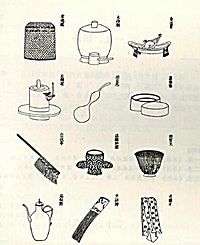Teaware
_with_Hare's_Fur_Pattern_LACMA_M.51.2.1.jpg)
Teaware encompasses a broad international spectrum of equipment used in the brewing and consumption of tea. Many components make up that spectrum, and vary greatly based upon the type of tea being prepared, and the cultural setting in which it is bring prepared. This is often referred to as the tea ceremony, and holds much significance in many cultures, particularly in northwestern Europe and in eastern Asia.
Components
- Teapots, which are used to steep the tea leaves in hot water
- Teacups, which are vessels from which to drink the hot tea out of which the leaves have been strained. There are many different kinds of tea cups.
- Tea strainers, for extracting leaves from tea solutions
- Tea trays, or draining trays, which are used to keep the tea and hot water from spilling onto the table.
- Tea bags and tea balls, which are used to hold tea leaves in water for removal after steeping.
- Tea caddies, for storing tea when not being consumed
Japanese tea ware

The following are a few of the essential components:
Tea bowl (茶碗, chawan). Tea bowls are available in a wide range of sizes and styles, and different styles are used for thick and thin tea. Shallow bowls, which allow the tea to cool rapidly, are used in summer; deep bowls are used in winter. Bowls are frequently named by their creators or owners, or by a tea master. Bowls over four hundred years old are in use today, but only on unusually special occasions. The best bowls are thrown by hand, and some bowls are extremely valuable. Irregularities and imperfections are prized: they are often featured prominently as the "front" of the bowl.
Tea whisk (茶筅, chasen). This is the implement used to mix the powdered tea with the hot water. Tea whisks are carved from a single piece of bamboo. There are various types. Tea whisks quickly become worn and damaged with use, and the host should use a new one when holding a chakai or chaji.
Tea caddy (棗, Natsume). The small lidded container in which the powdered tea is placed for use in the tea-making procedure ([お]手前; [お]点前; [御]手前, [o]temae).
Tea scoop (茶杓, chashaku). Tea scoops generally are carved from a single piece of bamboo, although they may also be made of ivory or wood. They are used to scoop tea from the tea caddy into the tea bowl. Bamboo tea scoops in the most casual style have a nodule in the approximate center. Larger scoops are used to transfer tea into the tea caddy in the mizuya (preparation area), but these are not seen by guests. Different styles and colours are used in various tea traditions.
Chakin (茶巾). The "chakin" is a small rectangular white linen or hemp cloth mainly used to wipe the tea bowl.
Construction
Tea equipment may be constructed of many materials, from iron in Japan to porcelain and clay in China, and also bamboo and other woods. Of particular repute are the Yixing clay teapots produced in eastern China.
Lu Yu’s Tea Ware (陸羽的茶具)
- crushing block (砧椎)
- brazier (風爐)
- charcoal basket (炭筥)
- charcoal mallet (炭檛)
- fire chopsticks (火筴)
- cauldron (鍑)
- cauldron stand (交床)
- tea tongs (夾)
- paper wallet (紙囊)
- crushing roller (碾)
- sieve box (羅合)
- tea holder (則)
- water vessel (水方)
- water filter bag (漉水囊)
- gourd scooper (瓢)
- bamboo tongs (竹夾)
- salt container (鹺簋)
- boiled water vessel (熟盂)
- bowl (碗)
- bowl basket (畚)
- brush (劄)
- water basin (滌方)
- spent tea basin (滓方)
- tea cloth (巾)
- utensil table (具列)
- utensil basket (都籃)
Old Man Shenan’s 12 Tea Ware (審安老人的12茶具)

- Brazier 風爐 (hong lu 韋鴻臚)
- Crushing Block 砧椎 (mu dai zhi 木待制)
- Crushing Roller 碾 (jin fa cao 金法曹)
- Stone Mill 石磨 ( shi zhuan yun 石轉運 )
- Gourd Scooper 瓢 (hu yuan wai 胡員外)
- Sieve Box 羅合 (luo shu mi 羅樞密)
- Brush 札 (zong cong shi 宗從事)
- Bowl Basket 畚 (qi diao mi ge漆 雕秘閣)
- Bowl 碗 (tao bao wen 陶寶文)
- Water Vessel 水方 (tang ti dian 湯提點)
- Tea Whisk 茶筅 (zhu fu shi 竺副師)
- Tea Cloth 巾 (si zhi fang 司職方)
The above tea wares were also mentioned by Lu Yu except for the stone mill (石磨) and tea whisk (茶筅)in The Classic of Tea .